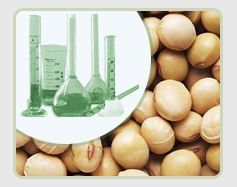FULL-FAT SOY-BEAN
ANALYSIS OF FULL-FAT SOY-BEAN
Soy-bean is a valuable fodder crop. The following is used for fodder purposes: press cake, oil cake, soy-bean flour, green mass.
By amino-acid composition soy-bean protein is identical to meat protein.
Various chemical composition of soy-beans allows to use them for food, fodder, and technical purposes. Soy-beans are used for production of milk, butter, margarine, flour, sausage products, confectionery, and many other products.
Table 1. Chemical composition of soy-bean
Substance
Content, %
Notice
Dry matter
93
-
Raw protein
38,0
-
Raw fat:
-
Specific weight 496 kg/m3
Extruded
18,0
-
By acid hydrolysis
19,5
-
Crude fiber
5,2
-
Ash
4,5
-
Protein digestibility
88,0
-
Protected protein
65
% from raw protein
Free fat acids
1,0
-
Linoleic acid
9,0
-
Linolenoic acid
2,0
-
Lecithin
0,7
-
Table 2. Amino-acid composition of soy-bean
Amino-acid composition
Minerals content
Substance
% in fodder
% from protein
Substance
Arginine
2,81
7,39
Macro, %
Calcium
0,25
Histidine
1,05
2,76
-
Phosphorous
0,6
Isoleucine
1,72
4,53
-
Sodium
0,02
Leucine
2,93
7,71
-
Chlorine
0,03
Lysin
2,40
6,32
-
Potassium
1,67
Methionine
0,54
1,42
-
Magnesium
0,26
Cystine
0,56
1,47
-
Sulphur
0,22
Phenylalanine
1,99
5,24
Micro, mg/kg
Copper
18
Tyrosine
1,52
4,00
-
Iron
80
Threonine
1,52
4,00
-
Manganese
30
Triptophane
0,59
1,55
-
Zinc
25
Valine
1,89
4,97
-
Selenium
0,11


